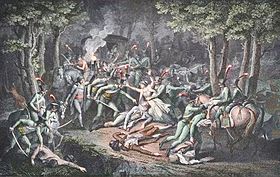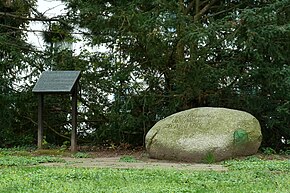Rastatt envoy murder
Coordinates: 48 ° 51 ′ 54.5 " N , 8 ° 11 ′ 58" E
The Rastatt envoy murder in the night hours of April 29, 1799 put an end to peace efforts between France and Austria .
The events in Rastatt
Four French diplomats, Antoine Bonnier d'Alco from Montpellier , president of the court there before the revolution, the lawyer Jean Antoine Debry (different spelling de Bry ), the former priest Claude Roberjot and the general secretary Heinrich Karl Rosenstiel were supposed to be during the Austro-Prussian French peace congress in Rastatt on certain issues arising from the peace of Campo Formio of 1797.
On March 10, the Commander-in-Chief of the Army, Archduke Karl , asked all French diplomats to leave Germany. Austrian MP Franz Georg Karl Graf von Metternich-Winneburg left the conference on April 13th. In the Karlsruher Zeitung he spread the following: "Now that the neutrality of the congress venue has ended, the French ministers will probably not stay here much longer either." But the French foreign minister Talleyrand ordered his people to continue spying.
On April 17th, the Austrian Colonel Joseph Barbaczy received the order to cordon off the place with his 11th Szekler Hussar Regiment , to check all French couriers and diplomats and to confiscate their secret papers.
The 97th and final conference took place on April 22nd. The next day the participating diplomats left, with the exception of the French, as the colonel announced that Rastatt would no longer be a conference venue without Metternich and that he could not guarantee their safety.
On April 28, he had the place occupied and cordoned off. The French received an ultimatum to leave within 24 hours. They did so the following night; they left Rastatt on April 28 at around 10 p.m.
What happened next was never clarified. Bonnier and Roberjot were murdered near Rastatt and solemnly buried there on the evening of April 29th. Debry was slightly wounded, but managed to escape "as if by a miracle" and initially hide in a forest until farmers brought him to the accommodation of the Prussian ambassador, Count Johann Eustach von Görtz , the next morning . Count Görtz took Debry in, had his wounds tended and protested sharply against the action of the hussars. Rosenstiel was also able to escape and found refuge in the quarters of the Baden MP Emanuel Meier , a member of Karl Friedrich von Baden's delegation .
Attempts to educate / theories about the instigators
Colonel von Barbaczy promised to investigate the case and arrest the murderers. Archduke Karl set up a commission on May 1, which met in Villingen in the Black Forest under the chairmanship of Count Johann Rudolf von Spork (1755-1806). Their secret work lasted half a year and ended with a newspaper note that the results had been sent to Vienna. There they disappeared without a trace.
Colonel von Barbaczy was subsequently arrested himself, along with several soldiers who had boasted of the crime, but were released shortly afterwards and promoted to major general. A robbery-murder charge fizzled out.
Immediately after the crime and throughout the 19th century, the question of who commissioned the murder was heatedly debated. Among the governments represented at the Rastatt Congress was not one that was not at some point accused of this crime by someone.
- The Board of the French Republic complained at the memorial service for Bonnier d'Alco and Roberjot, both the Council of Five Hundred had belonged to the British government as the author.
- Prussia accused Austria of having ordered the murder. Proponents of this thesis pointed out that Archduke Karl had the papers found on the two dead ambassadors sent to Vienna and had them presented to him. Since the Treaty of Basel between France and Prussia in 1795 , he feared further agreements between these two countries to the detriment of Austria.
- The French politician Jean-Pierre Fabre de l'Aude (1755-1832) accused Queen Maria Karolina of Naples-Sicily , her Prime Minister John Acton and the British government of the crime.
- The historian Carl Mendelssohn Bartholdy suspected the instigators to be in circles of French emigrants. The Baden lawyer Josef von Reichlin-Meldegg argued against this .
- The Baden historian Arthur Heinrich Böhtlingk (1849–1929) advocated the thesis that a faction of the Directory and Napoleon Bonaparte were behind the murder.
Commemoration
The course of events was staged with numerous illustrations, which were more or less precisely based on the circumstances.


The place where the murders were committed is in a small park near the intersection of “Am Gedenkstein” and “Kinkelstrasse”. The city of Rastatt erected a memorial stone and plaque here.
literature
(in order of appearance)
- Constantin von Wurzbach : Lehrbach, Ludwig Conrad Graf . In: Biographisches Lexikon des Kaiserthums Oesterreich . 14th part. Kaiserlich-Königliche Hof- und Staatsdruckerei, Vienna 1865, pp. 318–320 ( digitized version ).
- Carl Mendelssohn Bartholdy : The Rastatt envoy murder. Using handwritten material from the archives of Vienna and Karlsruhe . Bassermann, Heidelberg 1869.
- Josef von Reichlin-Meldegg : The Rastatt ambassador murder : illustrated and illuminated according to the sources. With 12 documented enclosures . Carl Winter, Heidelberg 1869. Full text in the Google book search
- Heinrich Heidenheimer: Reports on the Rastatt envoy murder. According to previously unknown files of the Grand Duke. Hessian State Archives . In: West German Journal for History and Art , vol. 2 (1883), pp. 131–162.
- Arthur Böhtlingk: Napoleon Bonaparte and the Rastatt envoy murder . Duncker & Humblot, Leipzig 1883.
- Arthur Böhtlingk: The Rastatt envoy murder before the Karlsruhe jury court. A record-based representation . Hörning, Heidelberg 1895.
- Hermann Hüffer : The Rastatt envoy murder with previously unprinted archive material . Röhrscheid & Ebbecke, Bonn 1896.
- Joseph Alexander von Helfert : To the solution of the Rastatt envoy murder question. Collected essays . Roth, Stuttgart 1900.
Individual evidence
- ^ Carl Mendelssohn Bartholdy: The Rastatt ambassador murder . Bassermann, Heidelberg 1869. p. 23.
- ^ Heinrich Heidenheimer: Information about the Rastatt ambassador murder . In: West German magazine for history and art , vol. 2 (1883), pp. 131–162, here p. 148.
- ^ Josef von Reichlin-Meldegg, "Der Rastatter Gesrafenmord", Carl Winter, Heidelberg 1869. pp. 8-12. . Google Books . Retrieved May 3, 2017.
- ↑ Josef von Reichlin-Meldegg, "The Rastatt Sent murder," Carl Winter, Heidelberg 1869. 15. . Google Books . Retrieved May 3, 2017.
- ↑ Josef von Reichlin-Meldegg, "The Rastatt Sent murder," Carl Winter, Heidelberg 1869. p.12 . Google Books . Retrieved May 3, 2017.
- ^ Heinrich Heidenheimer: Information about the Rastatt ambassador murder . In: West German magazine for history and art , vol. 2 (1883), pp. 131–162, here p. 148.
- ↑ Gräflich Rechbergsches Familienarchiv Donzdorf , HA K 34 - Letters from Aloys von Rechberg to his wife Marianne, April and May 1799.
- ↑ Meier's handwritten curriculum vitae in: Gereon Becht-Jördens, Der würkliche Geheime Rath and later Staats Rath Emanuel Meier (1746-1817). A life in the service of Karl Friedrich von Baden, in: Hermann Wiegand, Ulrich Nieß (Hrsg.): Karl Friedrich von Baden. Margrave, Elector, Grand Duke (series of publications by the Karl-Friedrich-Gymnasium Mannheim in cooperation with the Mannheim City Archives - Institute for City History 1). Wellhöfer, Mannheim 2012, pp. 95–135, here p. 121.
- ↑ Josef von Reichlin-Meldegg, "The Rastatt Sent murder," Carl Winter, Heidelberg 1869. S. 18 . Google Books . Retrieved May 3, 2017.
- ^ Heinrich Heidenheimer: Information about the Rastatt ambassador murder . In: West German magazine for history and art , vol. 2 (1883), pp. 131–162, here p. 132.
- ^ Johann Sporschil: History of the Germans from the oldest times up to our days , Volume 4, Georg Joseph Manz, Regensburg 2nd ed. 1859. P. 184.
- ^ Jean Pierre Fabre: Histoire secrète du Directoire , Vol. 4. Ménard, Paris 1832. P. 90.
- ^ Carl Mendelssohn Bartholdy: The Rastatt ambassador murder . Bassermann, Heidelberg 1869.
- ^ Josef von Reichlin-Meldegg, "Der Rastatter Gesrafenmord", Carl Winter, Heidelberg 1869. pp. 29–32. . Google Books . Retrieved May 3, 2017.
- ^ Arthur Böhtlingk: Napoleon Bonaparte and the Rastatt ambassador murder . Duncker & Humblot, Leipzig 1883 ( archive.org ).





